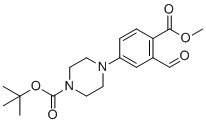tert‑Butyl 4‑(3‑formyl‑4‑(methoxycarbonyl)phenyl)piperazine‑1‑carboxylate is an organic intermediate that combines a piperazine core, a protected amine, and functionalized aryl substituents. Its structure features a piperazine ring (a six-membered diamine) where one nitrogen is protected by a tert‑butoxycarbonyl (Boc) group (making it a tert‑butyl carbamate), and the other nitrogen is attached to a phenyl ring. This phenyl ring bears two substituents: a formyl (–CHO) at the 3‑position, and a methoxycarbonyl (–CO₂Me) at the 4‑position.
Because of these functionalities, the compound is a versatile building block in medicinal chemistry. The formyl group allows for further derivatization: it can form Schiff bases (imines), be reduced to an alcohol, or be used to introduce other moieties through nucleophilic addition. The methoxycarbonyl group (an ester) provides a point for hydrolysis to give a carboxylic acid, or for coupling reactions (amide formation, for example). The Boc-protected piperazine enables selective deprotection later under acidic conditions, allowing one to expose one nitrogen after other transformations on the molecule have been performed.
In drug‑discovery contexts, such a compound is valuable for constructing small‑molecule libraries: medicinal chemists can modify the aryl substituents (via the formyl or ester), then deprotect the piperazine and append linkers, pharmacophores, or even macrocycles. This flexibility makes it useful as an intermediate in the synthesis of inhibitors, ligands, or bifunctional molecules (like PROTACs).
Synthesis of such a molecule would likely start from a suitably substituted bromobenzaldehyde or bromobenzoate: first, a piperazine coupling (e.g., via nucleophilic aromatic substitution or cross‑coupling) could attach the piperazine to the aryl ring. The methoxycarbonyl group may be introduced earlier, for example by esterifying a carboxylic acid precursor, then the Boc protection of the secondary amine would be installed. Alternatively, one may start from a Boc‑protected piperazine and perform an electrophilic aromatic substitution or a cross coupling to attach the substituted phenyl.
From a practical standpoint, this compound should be handled with the usual precautions for aromatic aldehydes and Boc-protected amines. The Boc group is acid-labile, so it should be stored in a dry, neutral-to-basic environment to avoid premature deprotection. The aldehyde group may be sensitive to oxidation and should be used under inert atmosphere if necessary.
In summary, tert‑butyl 4‑(3‑formyl‑4‑(methoxycarbonyl)phenyl)piperazine‑1‑carboxylate is a multifunctional synthetic intermediate widely applicable in medicinal chemistry for building more complex and biologically active molecules.
|




 GHS07 Warning Details
GHS07 Warning Details